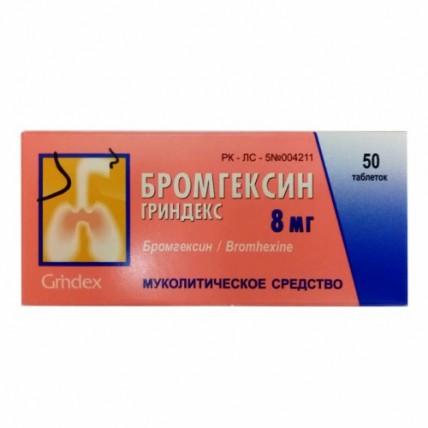Bromhexine 4/8 mg, 50 tablets
- $9.00
What is Bromhexine?
Bromhexine is a mucolytic medicine used to thin and loosen mucus in the respiratory tract.
It helps clear airways in conditions like bronchitis, asthma, and pneumonia.
By breaking down thick mucus, Bromhexine makes it easier to cough up phlegm.
It is commonly prescribed for both acute and chronic respiratory diseases.
Bromhexine also supports the production of surfactant, which improves lung function.
It should be taken after meals with plenty of water for optimal effectiveness
What is Bromhexine used for?
Bromhexine is used for secretolytic therapy in both acute and chronic respiratory diseases.
It helps manage conditions where mucus is difficult to expel, such as:
- Chronic bronchitis
- Asthma
- Pneumonia
- Bronchiectasis
How should Bromhexine be taken?
Adults and children over 14 years:
- The recommended dose is 8–16 mg (1-2 tablets of 8 mg) taken 3 to 4 times a day.
Children aged 6 to 14 years:
- The dose is 4–8 mg (1-2 tablets of 4 mg or ½–1 tablet of 8 mg) taken 3 times a day.
Bromhexine tablets should be taken orally after meals, with a glass of water, to enhance its mucolytic action.
The typical treatment duration is 4–6 days.
If there is no improvement after 5–6 days, it is recommended to consult a healthcare professional.
What precautions should be taken before using Bromhexine?
Before starting Bromhexine, it is important to consider the following precautions:
- Allergies: Avoid if you are allergic to Bromhexine or any of its ingredients.
- Stomach ulcers: Bromhexine can irritate the stomach lining and should be avoided if you have a history of stomach or duodenal ulcers.
- Liver or kidney impairment: People with severe liver or kidney problems should use Bromhexine with caution as it may not be easily eliminated from the body.
- Children under 6 years: Bromhexine in tablet form is not recommended for children younger than 6 due to swallowing difficulties. Use an alternative form instead.
Can Bromhexine be used during pregnancy or breastfeeding?
Bromhexine is not recommended during pregnancy or breastfeeding as there is not enough evidence to confirm its safety.
It is also known to pass into breast milk, so mothers should avoid using this medication while breastfeeding.
What are the possible side effects of Bromhexine?
Like all medications, Bromhexine can cause side effects, although not everyone experiences them. Common side effects include:
- Nausea or vomiting
- Stomach discomfort
- Sweating
- Rare but serious skin reactions such as Stevens-Johnson syndrome
In case of an allergic reaction (swelling of the face, difficulty breathing, rash), discontinue use immediately and seek medical attention.
How does Bromhexine interact with other medicines?
- Antitussives (e.g., codeine): Avoid taking Bromhexine together with cough suppressants as it may hinder mucus clearance.
- Antibiotics: Bromhexine can enhance the penetration of certain antibiotics (like erythromycin and cephalexin) into lung tissue.
- Nonsteroidal anti-inflammatory drugs (NSAIDs): Caution is needed when combining Bromhexine with NSAIDs as this may irritate the stomach lining.
- Alkaline solutions: Do not mix Bromhexine with alkaline solutions as they are not compatible.
How should Bromhexine be stored?
Store Bromhexine in a dry, dark place at a temperature below 25°C (77°F).
Keep it out of the reach of children and do not use it beyond the expiration date printed on the packaging.
What should you do in case of an overdose?
Overdose symptoms may include an increase in side effects such as nausea, vomiting, or stomach discomfort.
In such cases, contact a healthcare professional for advice.
Stomach lavage and symptomatic treatment may be recommended in severe cases.










